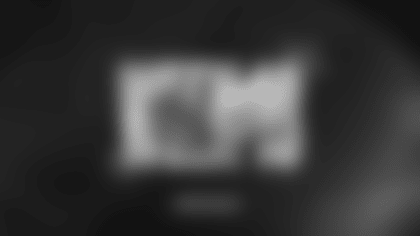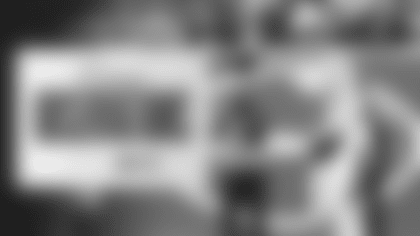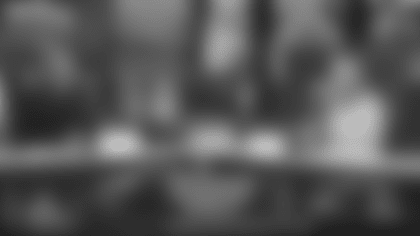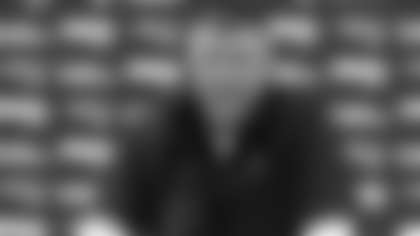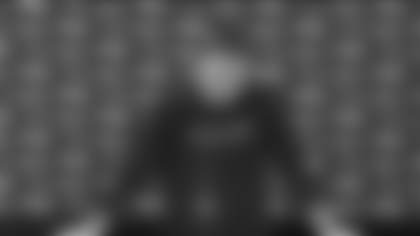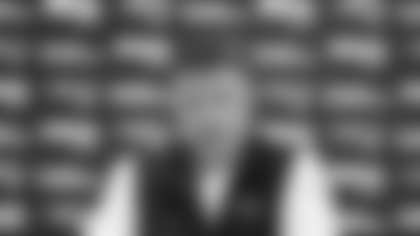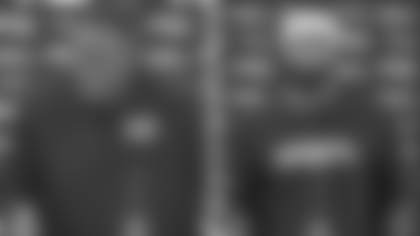NC: Well, good morning. I appreciate everybody being here this morning. It's been a few months since we've probably got together, since Bill [Belichick] got together with the group, been a couple of months. [We're] certainly excited. There are a lot of things going on here I would say with our team in the area of offseason program, winding down some of the draft visits, Celtics basketball so there's a lot going on. A few things before we get started into some of the questions. Quickly just on the Hall of Fame nominees, it's a great group. Certainly congratulations to those three players. [Raymond] Clayborn probably predates a lot of us in this room except for maybe Tom [Curran] when he was writing about him in his Saint Anselm dorm room. [He had] quite an accomplished career, 12 years, 161 straight starts, 37 career interceptions, a great football player. Mike [Vrabel] and Kevin [Faulk], can certainly speak a little bit more about them having been around them a little bit more. Those two players embody what the Patriot football program and what a football player is about. Kevin Faulk basically made himself into the great player that he was. There are stories that go back that he basically taught himself how to pass block. He didn't know how to do it when he got here. [He] worked with Dante [Scarnecchia] to try and get better in that area and he embodied a lot of things that we look for in football players. [He] was as dependable, was productive, and he's given back to football. [He's now] coaching down there in Louisiana. It's a credit to the career that Kevin has had. And Mike – Mike's career kind of speaks for itself. He was asked to do a number of different things, some of which he had never done before. He probably thought he had the best set of hands of anybody in the NFL. Quick story, we go out there for pregame warmups and I used to throw to him before the game and if the ball ever hit the ground it wasn't because of his hands, it was because the quarterback that was throwing was pretty bad. He always talked about his hands were better than Hines Ward but that was Mike. He played linebacker, played tight end, played free safety in practice. [They're] tremendous nominees. We'll see how the process goes but certainly a tip of the cap to that group and congratulations to them. As we kind of wind down here with the process, there are certainly a lot of people that have put in a lot of work, a lot of effort, a lot of people that are involved in the process. Certainly at the top of the list is Monti Ossenfort and his staff, nobody puts in more time. He has a tremendous amount of responsibility, he works diligently, he works very hard with myself and Coach Belichick and his staff – Smitty [Brian Smith], Lip [James Liipfert], DuJuan [Daniels] – those guys put in a lot of time, a lot of effort. It's kind of a culmination of a full year process, kind of a 12-month process that we'll start up here [and] really wind down here at the end of the week here next week. We're excited for the opportunity that we have in front of us. We're kind of turning the page. We're trying to put together the 2016 team. We've kind of bits and pieces done that a little bit to this point, so we'll continue that process next week or so and continue to add. I'm sure the composition of the team will change between now and ultimately when we first play in September, but that's kind of where we are here for the time being so we'll take some questions and go from there.
Q: What are some of your initial thoughts on the strengths and weaknesses of this particular draft class?
NC: The reality is that the draft – there's depth across all positions – I mean everybody always looks for what positions of strength, where is the draft deep. There's depth throughout the entire draft. You can really find players all the way from round one through seven. Other teams have done it; we've done it through the years. So it's not necessarily where they're drafted or where they come from or how they get there, it's just a matter of when you get them what they do when they're there. Really every position I would say you're going to find good football players top to bottom so it's just a matter of assigning your value to that player, what you think the players role is going to be for us specifically, and then incorporating that into our program. We're going through the process right now. We're winding down but I would say by the end of it we're only going to end up with X amount of players that we've considered drafting regardless of if its second round, third round, all the way down to the seventh round and then of course the undrafted component comes into play, which there's a number of players that have come into our program through the years – the Dane Fletchers, the David Andrews, the Brandon Kings, all those types of players – so you just go through the process and you just try to identify the fits and the players that you think have a chance to fit into what you're doing and then you pick them accordingly however it goes.
Q: How do you guys determine when it is OK to take a risk on a certain player that may have all the physical tools but has red flags in other areas?
NC: It's really relative to whatever else you may be looking at, at the time when you pick. So you grade the player for who the player is, you evaluate his play, and then we have a system in place that sort of marks it so we know whether it's an injury issue, whether it's a character issue, whatever the alert may be. So you evaluate the player numerically, you assign the grade, and then you just figure out based on relative to whatever else is available at the time when you pick, and then you just have to make the decision you feel makes the most sense for your team. I know Bill [Belichick's] talked about this countless times but it's a broad mosaic of things that go into the player. It's never one particular thing that you're evaluating. You're evaluating an entire body of work over the course of three or four years, however long a player's been in school. So you assign the value to the player, the grade, and then you'll just look across relative to the other players at whatever positon you may be picking and in the end you try to pick the players off how you think they're going to come off and then maybe relative to if you feel that you can get that player a little bit later. A lot of it is supply and demand so there are a number of factors that go into it. It's never really one thing.
Q: Without a first-round pick in this year's draft are you less prone to maybe taking a chance on a guy this year?
NC: I don't think it really changes the overall philosophy. You still go through the same process. The reality is that our process really hasn't changed this year relative to what we've done in previous years. We have the picks that we have and we go through a similar process. We grade the players and then we'll evaluate the players and then we'll look up there and see at the time that we pick, whenever that may be, what one player looks like relative to another. We've talked in the past about the vertical stacking and the horizontal stacking so that you're working individually by positon and then you start to work across positons and then just weigh those particular players. It could be one position versus another, offensive player versus defensive player, and then you may go back and then look at your team and say, 'OK, this maybe makes a little bit more sense or if we think if we pick this now then we think we can get this particular player later.' It all depends in the overall composition of the draft and how you think – you never really know how they're going to come off – but you have to make some kind of estimation of what you think makes the most sense.
Q: Would you agree that the wide receiver position is one of the more difficult positions to make the transition from college to the NFL?
NC: I wouldn't say that there's only one position. Look, the reality is that these players – I don't care where you played – you're making a significant jump from college football to NFL football. I would say college football has kind of evolved a little bit, both offensively and defensively systematically. Some players, honest to God, some offensive lineman have never been in a three-point stance so the number of times that they're actually going to be in a three-point stance and have to run block is going to be infinitely more than they did in college. There are some programs, honest to god, that throw the ball 75 times per game. They've never run blocked in their entire life so they're making a transition and they're going to be asked to do things that they haven't been asked to do before. So there are systematic issues, there are some communication issues just in terms of I would say offensively how teams operate. There's a lot of information that comes from the sideline. You're basically looking at one particular individual or one coach for a hand signal or a number or you're looking up at the cards. A lot of teams use those in college so you're basically wiping the slate clean and you're basically starting at a different point I would say regardless of the position so you have to take that all into consideration and then project them into your system and the things that you're going to ask them to do.
Q: Is this offense in particular more difficult for a wide receiver to adjust to due to all of the adjustments you make?
NC: I'd say it's difficult for a lot of people. I'd say the offensive line that they have as many demands and challenges as any skill player. Change in protections, making adjustments at the line of scrimmage late in the play clock, you have to get the communication from the center to the guard out to the tackle, we're going to go from one protection to this protection, we're going to go from a run play to a pass play. So I would say that there are a number of positions offensively that just there's a lot of communication and there's a lot of dialogue that is involved and some can handle it quicker than others, and then you figure out what they're learning mechanism may or not be and how to get them to a point where they can go out and operate and function at a competitive level. I think that's the most important thing.
Q: You've added quite a few free agents across the board in different positions. Does that take some of the pressure off of some of the upper level draftees to start or contribute right away?
NC: Look, every team goes through change during the offseason. You lose players, you sign players. We signed our share of players probably at a similar point to where we were last year. You make additions to your team but even when you make draft decisions I would say you sort of make them independent of one another. So, regardless of maybe you've signed a few more players at one positon relative to another that doesn't necessarily take you out of somebody if you feel – there are a lot of factors that go into it. Maybe a short term basis, maybe you look at a player on more of a short term basis versus if you draft a player hopefully he'll be in your program for three to four years, however long it may be. I would say we've built a team to where we are to a certain point but it doesn't necessarily change our overall philosophy or how we're going to try and add players to the team. We've talked about this in years past, say [Nate] Solder, we drafted Solder. He came in and basically he played jumbo tight end and right tackle because we had Sebastian [Vollmer] and we had Matt Light. Just because we had Matt and Sebastian didn't necessarily take us out of drafting Nate. You try to make the decision that you feel is best for your team based on the players that you're looking at on the board.
Q: With so many players coming from a spread-style system in college, what factors go into whether or not you think they'll be able to make the adjustment to an NFL system?
NC: I think you have to go through your process. You have to spend time with the player. You have to understand what they've been asked to do so that's whether it's a pre-draft workout, a pre-draft visit, an interview or whatever it may be, you're trying to ascertain information from them and find, 'OK, what were they asked to do?', and say, 'Ok, well here's what we're going to ask them to do. Do we feel that he's equipped enough to make that transition, handle that adjustment and that information?' So, you have to go through your process. Part of like I said, the on-campus visit or the interview, we'll go through an instillation, whether it's a rookie minicamp instillation, we'll install part of our offense and ask them here's how we teach it, here's the play, we'll go through it. OK, then you go out there and you walk through the play, you actually see how much they can retain. So there are a number of things that you can do to sort of anticipate how they would handle making that transition but the reality is that until you actually have them you really don't know, because maybe you find that their curve is a little bit quicker, it doesn't take them as long as originally you would've thought. You just kind of have to go through your process of gathering information and then make an assessment about how you feel that player is going to project into what you're going to ask them to do.
Q: How much does your pre-draft evaluation process change when you make changes to your coaching staff in the offseason?
NC: As far as which aspect?
Q: If you guys change a positional coach that perhaps has a certain idea of how he wants a player to play, does that change your evaluation of players during the offseason?
NC: There is a lot of back and forth. We talk I would say regularly with Bill [Belichick], myself, and there's a lot of communication back and forth. The coaches are involved in the process. You're trying to take all the information, put it all together, and then make an assessment of how you feel that player is going to adjust or project what you're going to ask them to do. Like I said, sometimes it takes players a little bit longer relative to others. There's a lot of information that goes back and forth. There's a lot of dialogue. We meet on a regular basis because in the end we're trying to get it right the best we can. The reality is that the way the draft is designed it doesn't always work out. I mean honestly at times it's a 50-50 coin flip. That's just the reality of it. So even if you think it's going to go a certain way, it may not go and you try to figure out, 'OK, well what can we do better or how can we adjust it?' We're always trying to look at different ways of doing things, look at our processes, whether that's playing, whether that's coaching, whether that's scouting, whether that's in the weight room, on a multitude of levels and just try to figure out if there's something that we can improve how can we improve it and then how do we implement that improvement moving forward.
Q: You seemed to say that the philosophy doesn't change but now said you may change things?
NC: What I was alluding to is our philosophy of scouting players, that hasn't changed for as long as Bill [Belichick's] been here. We still go through the same process so what part are you alluding to?
Q: So if you strike out on a particular player, then the philosophy that led you to draft him stays the same?
NC: We go through the same process every year. We evaluate the player, we meet the player, we spend time with them and we project them into the role. Sometimes it works the way you think it's going to, other times it doesn't work. We're looking at everything that we do in our program on a multitude of levels. I would say that the process of the scouting process from the beginning of, call it May of this time or April of this time last year until the end, just structurally how we do it. Now we may change a part of it but just from the beginning to the end of the process that you have to go through, you have to evaluate the player on their film, you go through the all-star process, you go through the combine, you go through the pre-draft process, you go through the workout, you go through the visit. Structurally, that stays the same. Now what you do within the context of that, if there's a better way to do it then we'll look at it.
Q: What are some of the challenges of having such a long wait between picks when you select in the third round and then not again until the sixth?
NC: We'll see. The most important thing is kind of knowing the draft from top to bottom. So if you do – I mean a couple of years ago we had five picks. We were going into the draft with five picks and we ended up with more so it can move both ways, so I think the most important thing is knowing the players, knowing who you're talking about, and then if you are going to make a decision to move up from where you are, who are you moving up for and what's the rationale. So you try to weigh out a number of different things as you're going through it. However it works itself out, we're prepared to pick either way whether it's from 96 to 196, whether we move, we're prepared, we're flexible. I think you have to keep an open mind with a lot of this. Nothings really set in stone, if you will. You have to be flexible, it's pretty fluid and you just have to be prepared for when every opportunity comes.
Q: How much have you and Coach Belichick talked privately about how asinine it is that you don't have a first round pick?
NC: Our philosophy is we control the things that we can control. Our job is to prepare for the draft and whatever our picks are then be prepared to pick. A lot of that is out of our hands. There's nothing we can do about that so there's no sense in spending extra time on it because there's nothing we can do about it. We're just going to try and prepare for the draft and take advantage of our opportunities when we pick.
Q: What is the long-term and short-term significance of not having a first-round pick?
NC: Like I said, we're prepared to pick whenever we pick and there's been many years where we haven't had a first round pick and we've adjusted accordingly. A couple of years ago we drafted [Patrick] Chung at the top of the second round. I think we didn't have a first round pick. Whenever we pick we're prepared to pick and we'll take advantage of the opportunities the best we can and try to add good players to our team. That's ultimately what we're trying to do.
Q: Would you acknowledge that you've been pretty successful on the first-round picks in the past?
NC: Look, we can't control where we pick. It's out of our hands. What we control is what we do with the pick when we have it and that's what we're prepared to do, and that's how we're going to approach it the next couple of weeks.











